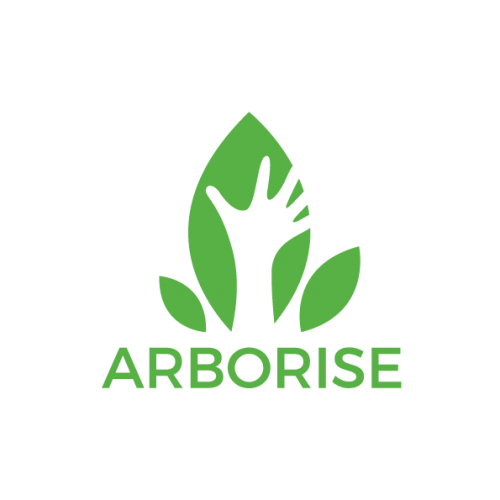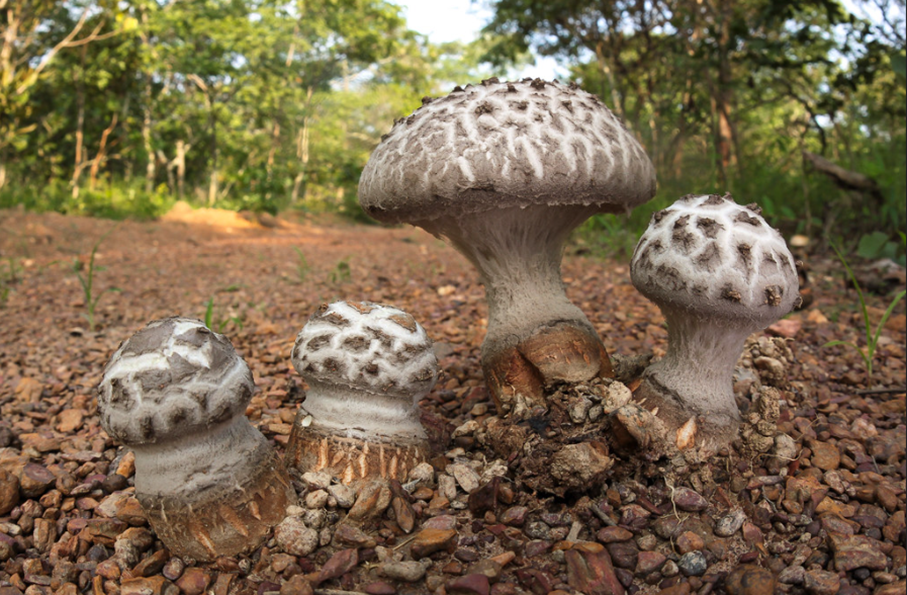In addition to its mission of participative and sustainable reforestation, the arboRise foundation has the statutory objective of “experimenting with natural reforestation methods that enhance biodiversity“. That’s why we asked ourselves how we could use mushrooms to make our trees grow.
We’ve known for several years that trees and fungi interact. In a nutshell:
- Some fungi link up with tree roots via their mycelium to help each other.
- Trees provide sugar to fungi in exchange for water and mineral salts
- Trees that benefit from this grow better
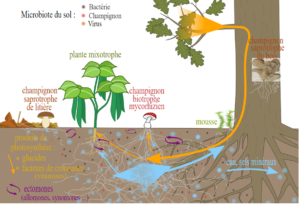

There are three types of fungi:
Saprophytes
- Saprophytic (or saprophagous) fungi feed on dead or decomposing organic matter. They play an essential role in the decomposition of dead organic matter, such as leaves, branches and plant debris. By breaking down complex organic matter into simpler compounds, they release nutrients into the soil.
- Although direct interactions between saprophytic fungi and mycorrhizal fungi are limited, saprophytic fungi contribute to the availability of nutrients, which can benefit mycorrhizal fungi by providing organic substrates. Since saprophytes feed on dead matter, they are not known to attack the seeds of living trees directly.
- Generally speaking, in cultivated soils, 20% of saprophytes and 80% of bacteria remain. When the field is left fallow, the saprophytic fungi grow and the pathogens disappear. So these saprophytic fungi play an important role in revitalising soil that has been impoverished by cultivation.
Endomycorrhizal fungi
- The mycelia of endomycorrhizal fungi penetrate plant roots and form structures called “arbuscules” or “vesicles” inside the root cells of the host plant. Thanks to this symbiosis, these fungi improve the removal from the external environment of the mineral nutrients they provide to their plant partner, the tree.
- In tropical zones, endomycorrhizal fungi dominate, although agriculture has a very negative impact on these arbuscular fungal communities (Arbuscular mycorrhizal fungal communities in sub-Saharan Savannas of Benin, West Africa, as affected by agricultural land use intensity and ecological zone). They are more common in the Sahelian-Sudanese zone, where the climate is drier, and associate with tree species such as :


- Endomycorrhizae generally do not produce sporocarps (what are commonly known as “mushrooms”, visible on the surface, which contain the spores needed for reproduction) and are therefore only present in the soil, around the roots of host plants. To collect inoculum, part of the root of the host tree must be removed.
- Endomycorrhizal fungi reproduce mainly asexually, producing spores inside the roots of the plants with which they form a symbiosis. These spores, known as arbuscules, are specialised structures that enable the fungus to propagate within the root cells of the host plant.
Natural inoculum is the simplest and least expensive way of achieving mycorrhization, and there is a very simple technique :
- A few weeks before the start of the rains, fill a sock with rice and bury it under a mature tree of the Parkia, Pterocarpus, Khaya, Prosopis, Erythrophelum, Daniellia, Anogeissus or Adansonia species (there is a high probability that this tree harbours endomycorrhizal fungi in its roots).
- Dig up the soil after a few weeks: the rice is full of mycorrhizae (white filaments). But be careful: the hyphae of the mycelium are fragile and must not be cut. A hypha isolated from the mycelial network will not survive. So remove the sock and the soil around it
- Bury this soil sock in the most humid part of the soil in the reforested area, close to the sown seeds. As soon as the seeds germinate, they will bind with the mycelium of the fungus, which will help them to grow.
Ectomycorrhizal fungi
- Ectomycorrhizal fungi are capable of mobilising and transferring to the host plant nutrients trapped in the soil’s organic matter (carbon, but also nitrogen, particularly that found in chitin). They regulate the balance between CO2 in the atmosphere and the amount of nitrogen in the soil by accelerating or reducing photosynthesis. They inhibit respiration in the soil by micro-organisms, reducing the outflow of carbon from ecosystems. Finally, the litter from ectomycorrhizal trees decomposes slowly due to the presence of secondary compounds that slow down the degradation of organic matter, helping to sequester carbon in the soil. These ectomycorrhizal symbioses therefore play a key role in climate regulation. Ectomycorrhizae also play a major role in the absorption of minerals such as phosphorus and potassium.
- Ectomycorrhizal fungi are rarer. They tend to be found in the tropical rainforests of the Guinean zone, where they associate with tree species such as Afzelia, Isoberlinia and Uapaca. This is particularly true of Isoberlinia and Uapaca, which grow on poor, leathery soils.
- In Guinea Forestière, ectomycorrhizal fungi are most often found in the Russula, Amanita and Lactarius genera. Ectomycorrhizal fungi have sporocarps (the fungi visible on the surface of the soil), so it’s easier to harvest their spores!
- The particular advantage of ectomycorrhizal fungi is their ability to supply organic nitrogen from the soil to the tree.
How can ectomycorrhizal fungi be used?
- Natural inoculum is the simplest and least expensive way of achieving mycorrhization. It can take the form of soil and humus from old plantations containing ectomycorrhizae, crushed sporophore, spores or excised roots. Inoculation of nurseries with spores has been the most common practice due to the number of spores available from fungi that fruit abundantly in forests and plantations.
- In practice, roots can be praline-coated with a spore suspension or sprinkled with dry spores. Seeds can also be coated with spores just before sowing.
- Harvest mature ectomycorrhizal fungi from Afzelia, Isoberlinia or Uapaca forests around May.
- Look for a dark place, away from light
- Place 10 mushrooms in each 10-litre bucket of water
- Crush and mix until you obtain a liquid purée of mushroom flesh full of spores
- Leave to infuse for 24 hours
- Add a spoonful of sugar to the solution and stir
- Soak the tree seeds in the mushroom purée and mix
- Sow the praline seeds
An interesting observation: Among the 40 species of arboRise trees, the early season species are more likely to use mycorrhizae:
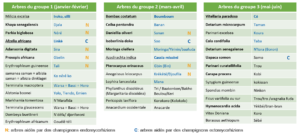

This is not surprising: January-February is the dry season and March is the hottest month. So it’s very useful for these tree species, which suffer from the climate, to be able to associate with fungi underground that provide them with water in exchange for sugars.
What are we going to test in 2024?
- The NGO AGIDE in Togo, headed by Mr Kossi Agbalenyo, is a specialist in the use of mycorrhizae in agriculture and reforestation. MYCOTRI, a 100% natural product marketed by AGIDE, contains spores of saprophytic fungi, which we will use to coat our tree seeds. These fungi will decompose the organic matter present in the reforested land and reduce the quantity of bacteria in soil that has been impoverished by cultivation. This will encourage the arrival of ectomycorrhizal and endomycorrhizal fungi, which will promote the growth of our trees.
- We are going to encourage a few interested land families to test both methods on their fields:
- grow endomycorrhizal fungi using the sock method
- grow ectomycorrhizal fungi to make spore mash and soak the seeds in it
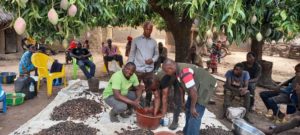

To find out more :
A book: The ectomycorrhizal fungi of forest trees in West Africa, Amadou Bâ, Robin Duponnois, Moussa Diabaté and Bernard Dreyfus, 2017.
Watch lectures by Marc-André Selosse, a soil microbiologist specialising in mycorrhizae:
Biological Functioning of Soils: https://www.youtube.com/watch?v=DAOdifyrfp4
- Mycorrhizae and mycorrhizal networks : From 4’47’20 to 5’35’30 (ectomycorrhizae: 4’56”30)
- Tropical forest diversity and succession: from 5’43’57 to 5’51’46
- Mycorrhizae and competition between species: 5’53’52 to 6’07’35 (depending on the mix of tree species per village, the results will differ with Mycotri because it will favour certain species which will take advantage over others).
- Mushrooms are also in the leaves! : 6’24’27 à 6’29’00
Mycorrhization – Mycorrhizae
- Ectomycorrhizae https://www.youtube.com/watch?v=pmjWysrPyJI
- Contribution of non-organic minerals by ectomycorrhizae: https://www.youtube.com/watch?v=6KbnCzU9yRM
- 4’20”: some ectomycorrhizae can provide the tree with mineral resources
- 8’37”: inoculation difficult only with spores… “mycorrhizal fungi are often found in dead wood because dead wood stores the water that the fungi seek”, “in tropical zones decomposition is strong and endomycorrhizal fungi are sufficient”).
- Applications https://www.youtube.com/watch?v=pJPze25Vods 6’12” renaturation of agricultural land: reforesting land cultivated with artificial fertilisers is difficult because there are no mycorrhizae left. Mycorrhizae must be added to nursery plants.
